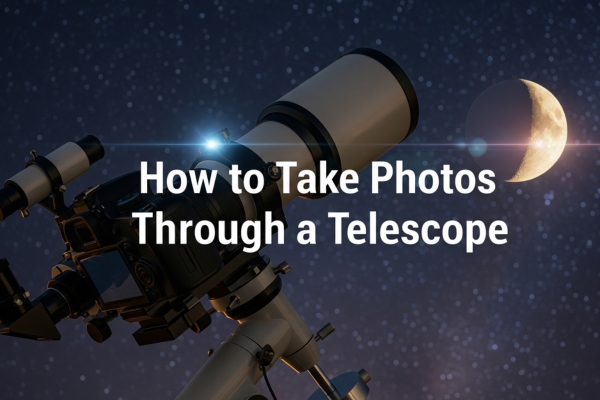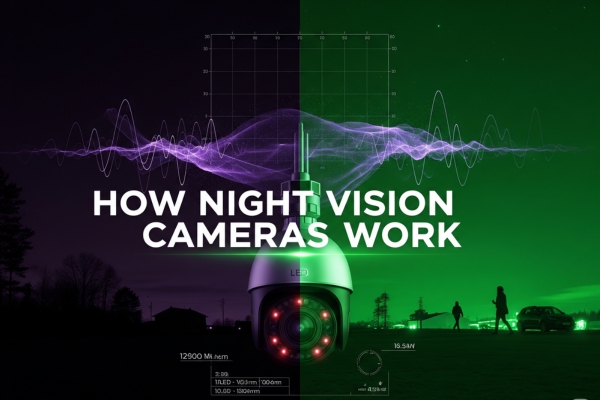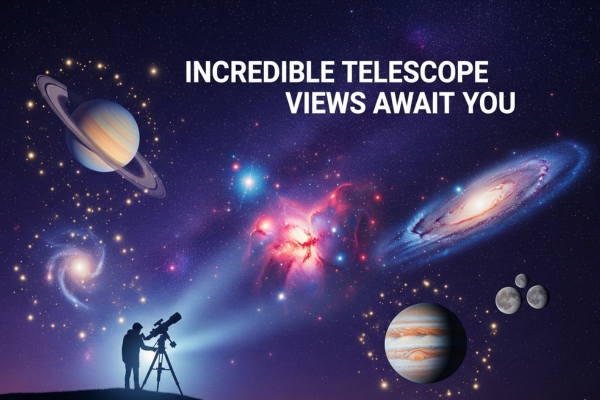



Ever wondered how night vision cameras can see perfectly in complete darkness? I’ve spent years working with different night vision technologies, and the science behind these devices is absolutely fascinating. Night vision cameras use three main technologies to capture images in low-light conditions: thermal imaging, infrared illumination, and image intensification. Each works differently but achieves the same goal – turning darkness into clear, usable images.
The ability to see in darkness has transformed everything from home security to wildlife photography. Modern night vision cameras can detect objects over 1,000 feet away in complete darkness, with some thermal systems reaching even further distances. Understanding how these technologies work helps you choose the right system for your needs and get the best performance from your equipment.
Night vision cameras work using three distinct technologies, each with unique advantages and applications. Thermal imaging detects heat signatures, infrared cameras use invisible light illumination, and image intensification amplifies existing light. Most people think all night vision is the same, but these technologies work in completely different ways.
Thermal cameras detect infrared radiation (heat) emitted by objects, typically in the 7-14 micrometer wavelength range. They create images based on temperature differences, showing warm objects as bright areas against cooler backgrounds. Infrared cameras illuminate scenes with near-infrared light (850-950 nanometers) invisible to human eyes but detectable by camera sensors. Image intensification systems amplify available light including starlight and moonlight by up to 50,000 times.
Thermal imaging cameras work by detecting infrared radiation naturally emitted by all objects above absolute zero (-273°C). The warmer an object, the more infrared energy it emits. Thermal sensors, typically made from vanadium oxide or amorphous silicon, convert this thermal energy into electrical signals that create visible images.
Professional thermal cameras use microbolometer arrays with thousands of tiny sensors, each measuring temperature differences as small as 0.05°C. These sensors change resistance when heated by infrared radiation, and sophisticated electronics convert these resistance changes into digital image data. The resulting image shows heat signatures as different colors or brightness levels.
I’ve tested thermal cameras in various conditions, and they work regardless of lighting. Complete darkness, bright sunlight, smoke, or fog – thermal cameras see heat signatures through it all. This makes them incredibly valuable for security applications where you need reliable detection 24/7. Body heat shows up clearly against cooler backgrounds, making human detection extremely reliable.
Infrared night vision cameras use LED arrays or laser illuminators to flood scenes with near-infrared light (typically 850nm or 940nm wavelengths). This light is completely invisible to human eyes but appears bright as daylight to camera sensors. Most security cameras use this technology because it’s cost-effective and provides excellent image quality.
The key component is the camera’s image sensor, usually a CMOS or CCD chip modified to be sensitive to near-infrared wavelengths. Standard cameras filter out infrared light, but night vision cameras either remove this filter or use sensors specifically designed for infrared sensitivity. This allows them to capture reflected infrared light and create detailed monochrome images.
Range depends on illuminator power and environmental conditions. Budget cameras might illuminate 30-50 feet effectively, while professional systems can reach 500+ feet. I’ve found that 940nm illuminators are less visible to wildlife and potential intruders (appearing as a very faint red glow), while 850nm LEDs are more efficient and provide better range.
Modern infrared cameras use smart illumination that adjusts LED power based on scene requirements. This prevents overexposure of nearby objects while maintaining visibility at distance. Some advanced systems use multiple illuminator arrays with different beam angles to provide both wide coverage and long-range detection.
Image intensification technology amplifies existing light sources like starlight, moonlight, or distant artificial lighting. These systems use photocathode tubes that convert photons into electrons, amplify the electron stream thousands of times, then convert back to visible light for viewing or recording.
The process starts with a photocathode surface (often made from gallium arsenide compounds) that releases electrons when struck by photons. These electrons pass through a microchannel plate with millions of tiny channels, each acting as an electron multiplier. A single electron entering a channel can produce thousands of electrons exiting, creating massive amplification.
Finally, these amplified electrons strike a phosphor screen that converts them back to visible light, typically in the characteristic green color associated with night vision goggles. Modern digital systems capture this intensified image with cameras for recording or transmission.
Image intensification works best when some ambient light exists. Complete darkness renders these systems ineffective unless combined with infrared illumination. However, they excel in low-light conditions like dawn, dusk, or urban environments with distant lighting.
Image intensification technology is classified into generations based on performance improvements and technological advances. Understanding these generations helps explain capability differences and why prices vary dramatically between systems.
Generation 1 systems provide 1,000-5,000x light amplification using basic photocathode technology. These entry-level systems work adequately in moderate low-light conditions but struggle in near-complete darkness. Image quality shows some distortion around edges, and tube life averages 1,000-2,000 hours of operation.
Gen 1 technology powers most consumer night vision devices under $500. While not military-grade, these systems work well for basic security monitoring or recreational use. I’ve used Gen 1 devices for property surveillance, and they provide usable images when streetlights or moonlight provide minimal illumination.
Generation 2 systems offer 20,000-25,000x amplification with significantly improved image quality and reduced distortion. These systems use microchannel plates for electron multiplication and gallium arsenide photocathodes for better sensitivity. Tube life extends to 2,500-5,000 hours.
Gen 2 technology provides the best value for professional applications requiring reliable performance without military-grade costs. Image quality is substantially clearer than Gen 1, with better resolution and less edge distortion. These systems work effectively in very low light conditions.
Generation 3 represents the current pinnacle of image intensification technology, offering 30,000-50,000x amplification with exceptional image quality. These systems use advanced gallium arsenide photocathodes and ion barrier films for extended tube life (10,000+ hours) and superior low-light sensitivity.
Gen 3 systems can detect objects in starlight-only conditions and provide sharp, clear images across the entire field of view. However, these systems cost $3,000-$10,000+ and face export restrictions due to military applications. For civilian use, the performance improvement over Gen 2 rarely justifies the massive cost increase.
Modern night vision cameras rely heavily on advanced sensor technology. CMOS and CCD sensors designed for low-light performance use larger pixel sizes to capture more photons per pixel, improving sensitivity in dark conditions. These sensors often sacrifice resolution for light sensitivity.
Back-illuminated CMOS sensors represent a major advancement, moving circuitry behind the photodiode to increase light-gathering area. Some sensors achieve ISO equivalents of 4,000,000 or higher, enabling color imaging in conditions previously requiring infrared illumination.
Sensor cooling also improves performance by reducing thermal noise that interferes with weak light signals. Professional night vision cameras may use thermoelectric cooling to maintain sensor temperatures well below ambient, dramatically improving signal-to-noise ratios in critical applications.
Traditional analog night vision uses physical image intensification tubes, while digital systems use electronic sensors and processing. Digital night vision cameras capture images with low-light sensors, then electronically amplify and enhance the resulting image using advanced algorithms.
Digital systems offer several advantages: they can record video directly, provide color imaging in some conditions, and cost significantly less than analog intensification tubes. Digital zoom, image stabilization, and real-time enhancement features aren’t possible with analog systems.
However, analog systems still excel in extreme low-light conditions where digital sensors struggle with noise. The instantaneous response of photocathode tubes also eliminates the lag sometimes present in digital processing. For critical applications requiring maximum light sensitivity, analog intensification remains superior.
Hybrid systems combine both technologies, using digital sensors with optional analog intensification for optimal performance across all lighting conditions. These versatile systems automatically switch between modes based on available light levels.
Night vision camera performance depends heavily on environmental conditions and application requirements. Thermal cameras excel in fog, smoke, or dust where visible light systems fail completely. However, they struggle to detect objects at ambient temperature and may miss threats behind glass barriers.
Infrared cameras provide excellent detail for identification purposes but require line-of-sight illumination and consume significant power for long-range applications. Range decreases substantially in rain or snow that scatters infrared light.
Weather significantly impacts all night vision technologies. Rain reduces range by scattering light and thermal signatures. Snow can mask thermal signatures while reflecting infrared illumination unpredictably. Fog blocks visible and near-infrared light but only moderately affects longer thermal wavelengths.
For security applications, I typically recommend infrared cameras for perimeter monitoring where detailed identification is crucial. The ability to capture facial features and read license plates makes infrared technology ideal for evidence collection. Modern cameras automatically switch between day and night modes as lighting conditions change.
Thermal cameras excel for detecting intrusions across large areas where identification matters less than detection. A thermal camera can monitor several acres effectively, immediately detecting any warm-blooded intruder regardless of camouflage or concealment attempts.
Combining both technologies provides comprehensive coverage – thermal for detection and infrared for identification. This layered approach ensures nothing is missed while providing actionable intelligence about detected threats.
Wildlife photographers increasingly use infrared trail cameras for monitoring animal behavior without human presence. These cameras can operate for months on battery power, capturing thousands of images when motion triggers activate the system.
Thermal imaging reveals animal behavior invisible to conventional cameras – tracking heat signatures through dense vegetation, monitoring den sites without disturbance, or studying nocturnal feeding patterns. I’ve captured incredible footage of owls hunting by following their heat signatures through complete darkness.
The key advantage is minimal impact on wildlife behavior. Infrared illumination doesn’t disturb most animals, allowing natural behavior observation. Some cameras use 940nm illuminators that are completely invisible to most wildlife while still providing excellent image quality.
Night vision camera costs vary dramatically based on technology and performance requirements. Basic infrared security cameras start around $50-100, while professional thermal imaging systems can exceed $10,000. Understanding your specific needs prevents overspending on unnecessary capabilities.
For home security, infrared cameras in the $200-500 range provide excellent value with adequate range and image quality for most applications. Professional installations might justify $1,000+ cameras with longer range and advanced features like analytics and remote monitoring.
Thermal cameras cost significantly more due to expensive sensor technology. Entry-level thermal systems start around $2,000, while professional models reach $15,000+. However, thermal’s unique capabilities often justify the cost for specific applications where conventional cameras fail.
Consider total system costs including installation, storage, and maintenance. A $200 camera requiring professional installation and ongoing monitoring fees might cost more long-term than a $500 camera with simple DIY setup and local storage.
Night vision technology continues advancing rapidly with new sensor materials and processing techniques. Quantum dot sensors promise improved sensitivity across broader wavelength ranges, potentially enabling single cameras to handle visible, near-infrared, and thermal imaging simultaneously.
Artificial intelligence integration is revolutionizing night vision capabilities. AI-powered cameras can distinguish between humans, vehicles, and animals automatically, reducing false alarms while ensuring critical threats receive immediate attention. Advanced algorithms also enhance image quality in real-time, extracting detail from extremely low-light conditions.
Miniaturization efforts are producing night vision capabilities in smartphone-sized packages. Consumer devices may soon include basic thermal imaging or advanced low-light sensors, democratizing night vision technology for everyday use.
Power efficiency improvements are extending battery life for portable systems. New LED technology provides longer-range infrared illumination while consuming less power, while more efficient sensors reduce overall system power requirements.
Thermal cameras work in complete darkness by detecting heat signatures, but infrared and image intensification systems require some light source. Most “night vision” security cameras use built-in infrared illuminators to provide invisible lighting for their sensors. True complete darkness requires thermal imaging technology.
Range varies significantly by technology and conditions. Basic infrared cameras see 30-100 feet effectively, while professional systems reach 500+ feet. Thermal cameras can detect large heat sources (like vehicles) over 1,000 feet away, but human detection typically ranges from 200-500 feet depending on sensor quality and atmospheric conditions.
No, night vision cameras cannot see through walls. Thermal cameras detect heat signatures on wall surfaces but cannot penetrate solid barriers. Some specialized military radar systems can detect movement through walls, but these aren’t considered night vision cameras and aren’t available for civilian use.
The characteristic green color comes from phosphor screens in image intensification tubes that convert electrons back to visible light. Green phosphor is used because human eyes are most sensitive to green wavelengths, providing the clearest detail perception. Digital night vision systems can display images in any color palette, including full color when sufficient light exists.
Most mammals cannot see near-infrared light used by night vision cameras (850-940nm wavelengths). However, some animals may detect the faint red glow from 850nm LEDs. Cameras using 940nm illuminators are virtually invisible to all wildlife, making them ideal for animal monitoring without behavioral disruption.
Digital night vision cameras using LED illumination can operate for years with minimal maintenance, similar to regular security cameras. Image intensification tubes have limited lifespans (1,000-10,000+ hours depending on generation), while thermal sensors can operate for decades with proper care. LED illuminators typically last 25,000-50,000 hours before requiring replacement.
Selecting appropriate night vision technology depends on your specific requirements and budget. For basic security monitoring with identification needs, infrared cameras provide the best value. These systems work reliably in most conditions and offer excellent image detail for recognizing faces or reading license plates.
Thermal cameras excel when detection matters more than identification, or when environmental conditions challenge other technologies. If you need to monitor large areas, detect intrusions through vegetation, or operate in fog and smoke, thermal imaging justifies the additional cost.
Image intensification suits applications requiring passive operation without artificial illumination. Military, law enforcement, and wildlife observation often prefer these systems to avoid revealing position or disturbing subjects.
Consider environmental factors affecting your installation. Urban areas with ambient lighting favor image intensification or low-light digital sensors. Rural locations with minimal lighting typically require infrared illumination or thermal detection. Harsh weather conditions may favor thermal imaging’s superior performance in precipitation and atmospheric interference.
Budget also influences technology choice, but don’t automatically choose the cheapest option. A slightly more expensive camera with better low-light performance often provides more reliable security than multiple cheaper cameras with marginal night capabilities.
Night vision cameras work through three main technologies – thermal imaging detecting heat signatures, infrared illumination providing invisible lighting, and image intensification amplifying available light sources. Each technology has unique advantages making them suitable for different applications and budgets.
Understanding how these systems work helps you choose the right technology for your needs and optimize performance for your specific conditions. Whether securing your property, monitoring wildlife, or pursuing professional surveillance, the right night vision technology can transform darkness from a limitation into an advantage.
The rapid advancement in sensor technology, processing power, and artificial intelligence continues improving night vision capabilities while reducing costs. What once required expensive military equipment is now accessible to consumers, bringing professional-grade night vision to security systems, wildlife monitoring, and recreational applications.
As night vision technology becomes more accessible and capable, understanding these underlying principles becomes increasingly valuable for making informed decisions about equipment selection and application. The darkness no longer needs to be a barrier when you understand how to see through it effectively.







